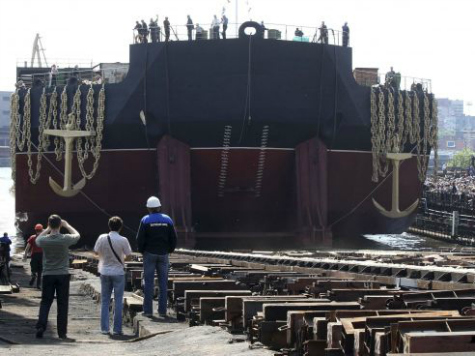Russia began a campaign in 2000 to construct seven floating nuclear power plants, but Moscow only built one due to strong Western environmental opposition and Russia’s weak economy. But now that Russia is under Western financial sanctions and China recently admitted its huge domestic effort to frack for natural gas has failed, the two nations are teaming up to launch a new era of floating nuclear power plants.
Russia’s nuclear leader Rosatom Corporation completed the Akademik Lomonosov (pictured) in July 2010 at a cost of $232 million, and it is set to be deployed as the world’s first floating nuclear power plant in Russia’s eastern Siberian city of Vilyuchinsk.
The vessel contains a pair of KLT-40 marine nuclear reactors that together would generate 70 megawatts (MW) of electricity or 300 MW of heat, enough to provide electricity to a city of 200,000 people. The floating nuclear power plants were designed to be mass produced for under $200 million in shipyards and then towed to coastal waters near a city or an industrial complex.
Russia’s design is a 474 ft. by 98 ft. barge that is 33 ft. high and has an underwater draught of 18 ft. The total weight of the barge would be 47.4 million pounds, and it would have an operating crew of 69 people. The nuclear reactor will only need to be refueled every three years and will save 225,000 metric tons of coal and 110,000 tons of fuel oil each year. The vessel’s lifespan is expected to be 40 years.
The world’s first floating nuclear power station was MH-1A. The reactor was built for the U.S. Army by Martin Marietta under a $17,200,000 contract in August 1961 and was laid in the hull of a World War II Liberty Ship named the Sturgis. MH-1A was towed to the U.S.-controlled Panama Canal Zone and provided 10 MW of reliable nuclear power for several years. In the 1970s a shipyard was built in Jacksonville, Florida, to build a series of much more powerful floating nuclear power plants along America’s East Coast. Technical challenges and environmental movements killed the project.
The potential benefits of floating nuclear power stations, according to a recent symposium hosted by the American Society of Mechanical Engineers and a group from the Massachusetts Institute of Technology, is that off-shore reactors would be safe from earthquakes and tsunamis and would solve the need to site power plants away from populated areas. Floating reactors would have plenty of water to generate turbine steam and the ocean would serve as an “infinite heat sink” to passively cool the reactor core, instead of “relying on pumps driven by electricity, which could fail,” such as in the Fukushima nuclear disaster in Japan in 2011.
China became the largest global energy consumer in 2010 and passed the U.S. as the largest net oil importer in early 2014. Addicted to burning highly polluting coal for 70% of its energy needs and 80% of its electricity, China now burns 47% of the world’s coal and has 16 of the world’s 20 most polluted cities.
With rising volumes of imported oil and LNG costing 3-4 times as much as domestically produced natural gas, China’s industrial competitiveness has plummeted. Exports fell from 39% to 26% of China’s GDP over the last five years. China launched a five-year $275 billion crash investment to begin fracking shale last year as a plan to reinvigorate its manufacturing base, but last week China quietly admitted the plan has failed.
With Russia under financial sanctions and China now desperate to gain domestic energy, neither country cares how much Western nations and environmentalist organization scream about the risk of off-shore nuke plants.
Rosatom is already building four nuclear reactors at China’s Tianwan power station with a combined capacity of 1060 MW. There are currently 29 nuclear power plants under construction in China, and the country has plans to build 200 more. The six Chinese offshore floating reactors Rosatom will build will only add 450 MW. But launching the first commercial floating nuclear power stations is just the beginning of a new era.
The author will respond to readers’ comments.

COMMENTS
Please let us know if you're having issues with commenting.